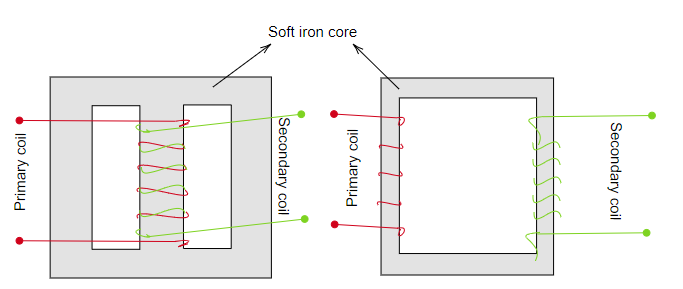
What are the parts of the transformer?
Answer
218.7k+ views
Hint: Transformers works on the principle of mutual induction. It helps in changing the alternating voltage from one to another of greater or smaller value. It mainly consists of two coils insulated from each other and it is usually wound on a soft iron core or magnetic core.
Complete answer:
* The transformers work on the principle of mutual induction, which can be defined as the change in electric current passing through one coil induces an emf in the neighbouring coil and the induced emf is called mutually induced emf.
* The parts of the transformer are the primary coil and the secondary coil which is wound on a soft iron core and insulated from each other. They are either wounded on top of the other or on separate limbs of the soft iron core or magnetic core.
* When an alternating voltage is applied to the primary coil, it produces an alternating magnetic flux that links the secondary coil and induces an emf in it.
*The transforms are mainly used in the process where it is necessary to change the alternating voltage from one or another of greater or smaller value. So the transformer is of two types.
1. Step-up transformer
2. Step-down transformer
* In the transformer, when the alternating voltage in the primary coil is less than the secondary coil it is called step-up transformer, similarly, when the primary coil has higher alternating voltage than the secondary coil, then it is a step-down transformer.
So the main parts of the transformer are, 1. Primary coil, 2. Secondary coil, 3. Magnetic core. The other parts which are used in the overall process are vents, shafts, brushes, etc,.
Note: Usually the primary coil is used to apply the alternating current and the secondary coil is where the induced emf is measured. The value of this emf is based on the number of turnings of the secondary coil. The number of turns of the primary coil is \[{N_p}\] and the number of turns for the secondary coil is \[{N_s}\] .
Complete answer:
* The transformers work on the principle of mutual induction, which can be defined as the change in electric current passing through one coil induces an emf in the neighbouring coil and the induced emf is called mutually induced emf.
* The parts of the transformer are the primary coil and the secondary coil which is wound on a soft iron core and insulated from each other. They are either wounded on top of the other or on separate limbs of the soft iron core or magnetic core.
* When an alternating voltage is applied to the primary coil, it produces an alternating magnetic flux that links the secondary coil and induces an emf in it.

*The transforms are mainly used in the process where it is necessary to change the alternating voltage from one or another of greater or smaller value. So the transformer is of two types.
1. Step-up transformer
2. Step-down transformer
* In the transformer, when the alternating voltage in the primary coil is less than the secondary coil it is called step-up transformer, similarly, when the primary coil has higher alternating voltage than the secondary coil, then it is a step-down transformer.
So the main parts of the transformer are, 1. Primary coil, 2. Secondary coil, 3. Magnetic core. The other parts which are used in the overall process are vents, shafts, brushes, etc,.
Note: Usually the primary coil is used to apply the alternating current and the secondary coil is where the induced emf is measured. The value of this emf is based on the number of turnings of the secondary coil. The number of turns of the primary coil is \[{N_p}\] and the number of turns for the secondary coil is \[{N_s}\] .
Recently Updated Pages
A square frame of side 10 cm and a long straight wire class 12 physics JEE_Main

The work done in slowly moving an electron of charge class 12 physics JEE_Main

Two identical charged spheres suspended from a common class 12 physics JEE_Main

According to Bohrs theory the timeaveraged magnetic class 12 physics JEE_Main

ill in the blanks Pure tungsten has A Low resistivity class 12 physics JEE_Main

The value of the resistor RS needed in the DC voltage class 12 physics JEE_Main

Trending doubts
JEE Main 2026: Application Form Open, Exam Dates, Syllabus, Eligibility & Question Papers

Derivation of Equation of Trajectory Explained for Students

Hybridisation in Chemistry – Concept, Types & Applications

Understanding the Angle of Deviation in a Prism

Understanding Collisions: Types and Examples for Students

Understanding Atomic Structure for Beginners

Other Pages
JEE Advanced Marks vs Ranks 2025: Understanding Category-wise Qualifying Marks and Previous Year Cut-offs

How to Convert a Galvanometer into an Ammeter or Voltmeter

Understanding Centrifugal Force in Physics

JEE Main Marking Scheme 2026- Paper-Wise Marks Distribution and Negative Marking Details

Degree of Dissociation: Meaning, Formula, Calculation & Uses

Understanding Electromagnetic Waves and Their Importance




